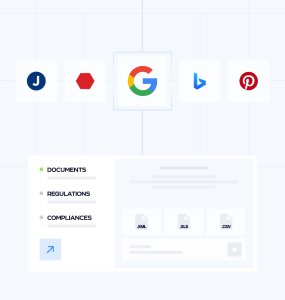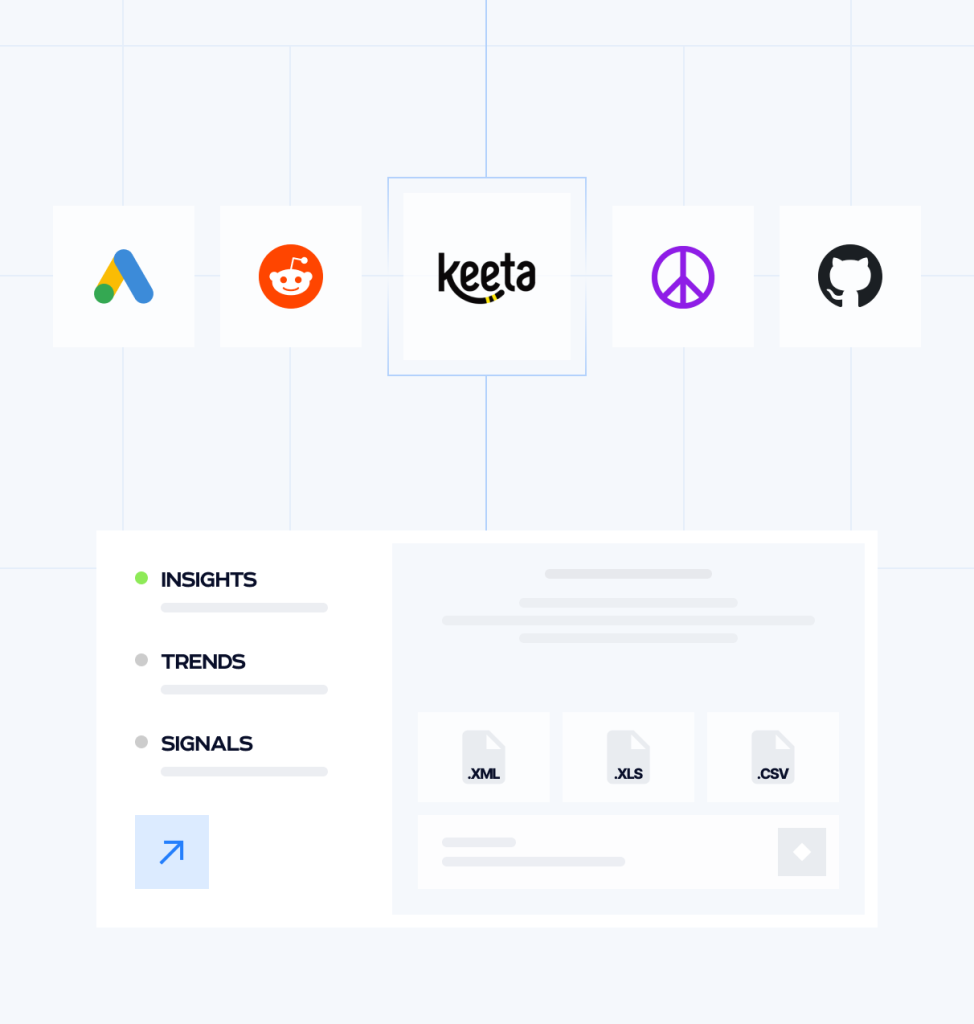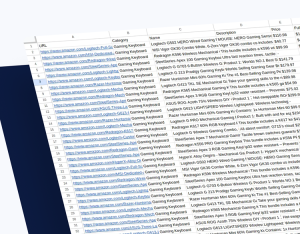
web scraping services
Reliable, Timely & Scalable
Custom Solutions Since 2015
DataOx provides professional web scraping services for businesses that need reliable data extraction. Our automated solutions collect, process, and deliver structured data from any source. We help companies access valuable information, reduce manual work, and make better decisions with accurate, timely data.

A Reliable Partner For All
Web Scraping Data Needs
A Reliable Partner For All Web Scraping Data Needs
DataOx offers comprehensive web scraping serviсes for automated data collection which include real-time extraction, data processing, custom format delivery, and reliable maintenance.
Real-Time Scraping
Scheduled Scraping
AI-Powered Data Scraping
Mobile App Data Extraction
Enterprise Web Scraping
Price & Review Monitoring
Lead Generation Scraping
Custom Web Scraping
Real-Time Scraping
Instant data delivery as it happens — no delays, no outdated information
DataOx builds real-time scraping systems that capture and deliver data the moment it appears online — perfect for price monitoring, stock tracking, and time-sensitive business decisions.
Live data streaming from any website
Instant notifications on data changes
Sub-second response times for critical updates
Real-time APIs for immediate integration
Automatic alerts for price drops or stock changes
Built for high-frequency data collection and instant delivery
Perfect for trading, monitoring, and competitive intelligence
Scheduled Scraping
Automated data collection on your schedule — set it and forget it
DataOx creates automated scraping systems that collect data exactly when you need it — daily reports, weekly updates, or custom intervals that match your business rhythm.
Flexible scheduling: hourly, daily, weekly, or custom intervals
Automated data delivery to your preferred location
Consistent data collection without manual intervention
Smart retry logic for maximum reliability
Bulk data processing for large-scale operations
Perfect for regular reporting and business intelligence
Built for consistency, automation, and scalable data workflows
AI-Powered Data Scraping
Smart extraction that understands content — like having an expert data analyst
DataOx combines artificial intelligence with web scraping to automatically recognize, categorize, and clean data from complex websites — turning messy information into structured, ready-to-use datasets.
Intelligent content recognition and categorization
Automatic data cleaning and validation
Smart pattern detection for complex layouts
AI-based duplicate removal and data enhancement
Natural language processing for text analysis
Adaptive scrapers that learn from website changes
Built for accuracy, intelligence, and premium data quality
Mobile App Data Extraction
Access mobile-only data that traditional scrapers can’t reach
DataOx extracts valuable data directly from mobile applications — capturing app-exclusive content, mobile-specific pricing, and user interactions that aren’t available on desktop websites.
Direct mobile app data extraction capabilities
Access to mobile-exclusive content and features
App store data collection and analysis
Mobile user behavior and interaction tracking
iOS and Android app data extraction
Mobile-specific pricing and offer monitoring
Built for mobile-first businesses and app intelligence
Enterprise Web Scraping
Industrial-scale data collection for large organizations
DataOx delivers enterprise-grade scraping solutions that handle massive data volumes, complex compliance requirements, and mission-critical business operations with guaranteed uptime and security.
Large-scale data collection for enterprise needs
Advanced security
Dedicated infrastructure and priority support
Custom agreements and guaranteed uptime
Integration with enterprise systems and databases
Multi-region data collection and processing
Built for scale, security, and enterprise reliability
Price & Review Monitoring
Stay ahead of competition with automated market intelligence
DataOx monitors prices, reviews, and competitor activities across multiple platforms — delivering real-time insights that help you make informed pricing decisions and respond to market changes instantly.
Automated price tracking across multiple platforms
Review and rating monitoring for brand intelligence
Competitor analysis and market positioning insights
Real-time alerts for price changes and new reviews
Historical data tracking and trend analysis
Custom reporting and dashboard integration
Built for competitive intelligence and market leadership
Lead Generation Scraping
Find and qualify prospects automatically — fuel your sales pipeline
DataOx builds lead generation systems that automatically discover, verify, and enrich prospect data from multiple sources — delivering sales-ready leads with accurate contact information and company insights.
Contact information extraction and verification on demand
Company data enrichment and profiling
LinkedIn and professional network lead extraction
Industry trend monitoring
Social media profile and activity tracking
Email and phone number validation
Custom Web Scraping
Tailored solutions for unique data challenges — exactly what you need
DataOx creates completely custom scraping solutions for unique business requirements — handling complex websites, special data formats, and specific workflow integrations that standard solutions can’t address.
Fully custom scrapers for unique requirements
Complex website and data format handling
Specialized anti-bot and protection bypass
Custom data processing and transformation
Bespoke delivery formats and integrations
Ongoing customization and feature development
Built for unique challenges and specific business needs
A Reliable Partner For All Web Scraping Data Needs
DataOx offers comprehensive web scraping serviсes for automated data collection which include real-time extraction, data processing, custom format delivery, and reliable maintenance.
need custom data scraping that leads? let’s talk!
Whether you’re planning your first web scraping project or already have specific data requirements, our scraping experts would be glad to learn about your needs and make automated data extraction work for your business. Just drop us a line.
industries we serve
Discover how our data scraping services help businesses like yours extract value from public websites and app data — across industries.







Job & HR
Information Services
Social Media & Trends
E-commerce
Legal & Compliance
AI-Powered SaaS
Finance
Real Estate
Job & HR
We help HR teams and recruiters save
hours by scraping jobs from the internet:
job listings, candidate profiles, and contact data — all in one place.
Smart Hiring with Web Scraping Jobs
Glassdoor
Indeed
ZipRecruiter
Wellfound
Workable
Monster
Fiverr
Angellist
Information Services
Get structured data from public websites, news, and registries — ready to use, no manual copy-paste.
Web Scraping News Articles. Structured Data from Public Sources
Wikipedia
Google News
MSN News
Google Trends
Crunchbase
Yahoo
Google Maps
The New York Times
BBC
CNN
Yelp
Bloomberg
Reuters
Social Media & Trends
Track social trends, hashtags, comments, and sentiment across social media platforms — for better decisions and campaigns.
Social Media Data Collection & Trend Monitoring
X
META ads
YouTube
TikTok
Quora
E-commerce
We scrape ecommerce data from top marketplaces — including price scraping, review monitoring, and stock tracking. Our ecommerce scrapers are perfect for price monitoring, review tracking, and competitive product analysis.
Ecommerce Scrapers for Price & Product Review Monitoring
Amazon
eBay
Walmart
Aliexpress
Alibaba
Shopee
Etsy
Target
BestBuy
Zalando
Lazada
Legal & Compliance
We help businesses protect their brands and content online. From copyright enforcement to review and brand monitoring, we scan the web for trademark misuse, unauthorized mentions, illegal image use, and policy violations — at scale.
Brand Protection, Copyright & Review Monitoring
Google Images
Bing Images
Marketplaces
Review sites
Social media
Media platforms
Job Boards
AI-Powered SaaS
We deliver high-volume, structured datasets to fuel AI SaaS products, analytics platforms, and recommendation systems. Our data powers everything from product-matching models to visual dashboards — sourced directly from mobile apps and web versions of marketplaces and delivery platforms.
Data Delivery for AI Products & Platforms. Perfect for: product-matching AI, pricing intelligence, competitor analysis, insights, and visualization.
Amazon
eBay
Craigslist
Keeta
HuggingFace
GitHub
G2
Hungerstation
Linneman
Finance
Get live stock prices, crypto rates, and company fundamentals — all through structured, flexible feeds. We specialize in scraping financial data and financial data aggregation, with real-time insights from trusted sources. From web scraping stock market data to crypto pricing, our service delivers everything you need for smarter decisions.
Real-Time Financial & Crypto Data
Yahoo Finance
TradingView
MarketWatch
SEC
CoinMarketCap
Real Estate
We help real estate professionals, investors, and market analysts access comprehensive property data — from listings and pricing to market trends and agent contacts.
Property Data Collection & Market Analysis
Zillow
Airbnb
Realtor.com
Yelp
Apartments.com
Craigslist
Redfin
LoopNet
Job & HR
We help HR teams and recruiters save
hours by scraping jobs from the internet:
job listings, candidate profiles, and contact data — all in one place.

Smart Hiring with Web Scraping Jobs
Glassdoor
Indeed
ZipRecruiter
Wellfound
Workable
Monster
Fiverr
Angellist
Information Services
Get structured data from public websites, news, and registries — ready to use, no manual copy-paste.

Web Scraping News Articles. Structured Data from Public Sources
Wikipedia
Google News
MSN News
Google Trends
Crunchbase
Yahoo
Google Maps
The New York Times
BBC
CNN
Yelp
Bloomberg
Reuters
Social Media & Trends
Track social trends, hashtags, comments, and sentiment across social media platforms — for better decisions and campaigns.

Social Media Data Collection & Trend Monitoring
X
META ads
YouTube
TikTok
Quora
E-commerce
We scrape ecommerce data from top marketplaces — including price scraping, review monitoring, and stock tracking. Our ecommerce scrapers are perfect for price monitoring, review tracking, and competitive product analysis.
Ecommerce Scrapers for Price & Product Review Monitoring
Amazon
eBay
Walmart
Aliexpress
Alibaba
Shopee
Etsy
Target
BestBuy
Zalando
Lazada
Legal & Compliance
We help businesses protect their brands and content online. From copyright enforcement to review and brand monitoring, we scan the web for trademark misuse, unauthorized mentions, illegal image use, and policy violations — at scale.

Brand Protection, Copyright & Review Monitoring
Google Images
Bing Images
Marketplaces
Review sites
Social media
Media platforms
Job Boards
AI-Powered SaaS
We deliver high-volume, structured datasets to fuel AI SaaS products, analytics platforms, and recommendation systems. Our data powers everything from product-matching models to visual dashboards — sourced directly from mobile apps and web versions of marketplaces and delivery platforms.

Data Delivery for AI Products & Platforms. Perfect for: product-matching AI, pricing intelligence, competitor analysis, insights, and visualization.
Amazon
eBay
Craigslist
Keeta
HuggingFace
GitHub
G2
Hungerstation
Linneman
Finance
Get live stock prices, crypto rates, and company fundamentals — all through structured, flexible feeds. We specialize in scraping financial data and financial data aggregation, with real-time insights from trusted sources. From web scraping stock market data to crypto pricing, our service delivers everything you need for smarter decisions.

Real-Time Financial & Crypto Data
Yahoo Finance
TradingView
MarketWatch
SEC
CoinMarketCap
Real Estate
We help real estate professionals, investors, and market analysts access comprehensive property data — from listings and pricing to market trends and agent contacts.

Property Data Collection & Market Analysis
Zillow
Airbnb
Realtor.com
Yelp
Apartments.com
Craigslist
Redfin
LoopNet

collect data from anywhere, deliver everywhere
Get data scraped from any source and delivered automatically in your preferred format with DataOx’s custom web scraping services
Ebay
Zillow
Yahoo F.
YouTube
Craiglist
Indeed
X
Amazon
Yelp
Database
Insights
API
Dashboards
Analytics
XLSX
CSV
JSON
XML
CRM
use cases
talent intelligence & recruitment data
Streamline recruitment and talent acquisition processes
Extract job postings, candidate profiles, and salary data from multiple platforms to optimize hiring strategies. Essential for HR SaaS tools, departments, recruitment agencies, and talent acquisition teams.

news monitoring
Transform data streams into competitive intelligence
Aggregate news, reports, and industry publications to deliver real-time insights and content curation. Perfect for information service providers, media companies, and research organizations.

e-commerce product intelligence
Maximize profitability through intelligent product and pricing data
Monitor competitor prices, analyze product reviews, and track inventory across multiple e-commerce platforms in real-time. Essential for online retailers, e-commerce managers, and pricing strategists.

social media & consumer trends intelligence
Unlock consumer insights from social platforms
Monitor TikTok, Instagram, LinkedIn, and other platforms to track consumer sentiment, brand mentions, and emerging trends. Ideal for marketing teams, brand managers, and market researchers.

compliance intelligence & legal monitoring
Ensure regulatory compliance through automated monitoring
Track legal documents, regulatory changes, and compliance requirements across jurisdictions. Essential for legal firms, compliance departments, and regulated industries.

market intelligence & business analytics
Turn web data into actionable business insights
Collect market data, consumer sentiment, and industry trends from multiple sources to make informed business decisions. Essential for market researchers, analysts, and strategic planners.

data categories we scrape across industries
Job Boards
Job
Social Media
Social
News
News
E-commerce
E-commerce
Finance
Finance
Job Boards data categories for web scraping
We can build your feeds to pull in any category you need, whether standard or custom, and provide Quality Assurance and compliance out of the box.
Location
Industry
Salary estimate
Keywords
Company size
Working mode (FT/PT)
Education Level
Contract vs Employee
Senior vs Entry Level
Remote vs In office
Social Media data categories for web scraping
We can build your feeds to pull in any category you need, whether standard or custom, and provide Quality Assurance and compliance out of the box.
Post content
Engagement metrics
User profiles
Hashtag trends
Follower data
Comments
Influencer metrics
Brand mentions
Viral content
Audience demographics
Competitor analysis
Campaign performance
News data categories for web scraping
We can build your feeds to pull in any category you need, whether standard or custom, and provide Quality Assurance and compliance out of the box.
Article content
Headlines
Publication dates
Author information
Categories
Social engagement
Brand mentions
Sentiment analysis
Trending topics
Source credibility
Geographic coverage
Industry focus
E-commerce data categories for web scraping
We can build your feeds to pull in any category you need, whether standard or custom, and provide Quality Assurance and compliance out of the box.
Product information
Pricing data
Customer reviews
Inventory levels
Seller details
Category rankings
Competitor analysis
Promotional offers
Product variants
Market trends
Finance data categories for web scraping
We can build your feeds to pull in any category you need, whether standard or custom, and provide Quality Assurance and compliance out of the box.
Market prices
Trading volumes
Company financials
Economic indicators
Regulatory updates
Investment data
Analyst reports
Market sentiment
Risk metrics
Currency rates
Crypto data

data delivery formats
Choose the format that works best for your workflow
We deliver extracted data in multiple formats with full customization options. Whether you need instant access, automated integration, or specific file structures – we've got you covered.
CSV
CSV
Excel (XLSX) / Google Sheets
Excel
JSON
JSON
API Integration
API
Database Direct
Database
Custom
Custom
8 Years of Uninterrupted Growth: How We Built the Ultimate AI Recruitment Platform from Scratch
Challenge
Discovered as the recruitment automation company needed to develop and scale AI-powered tools for small and mid-sized businesses. The core product – a customizable interview guide generator – required continuous development, enhancement, and strategic technical implementation to stay competitive in the rapidly evolving HR tech market.
Solution
Services delivered
Data Services:
- Data integration
- IDP (Intelligent document processing)
Development services:
ATS (application tracking system) development
- API development
- Full-stack Custom SaaS development
- AI-driven behavior automation implementation
- Continuous platform enhancement and maintenance
- Advanced onboarding system development

client priority
Team stability and dedicated support – ensuring consistent development team throughout the 8+ year partnership
Results
Platform Scale & Performance:
- 900K+ candidates in the system with 780K resumes
- 3.8K active job openings from 20K total posted
- 2.5K active client companies with 1K new companies added annually
- 3TB of data storage (AWS S3) supporting massive operations
- 120K assessments completed in the last year
- 20K video interviews conducted and processed
need accurate, reliable data?
You’re in the right place. Let’s talk
our simple 5-step process
Getting started with DataOx.
Step 1
Send Us a Request
Choose the Most Convenient Way to Reach Us
You can contact us through the channel that works best for you:
Email hello@data-ox.com or any contact button on our website. Our average response time is 2-4 hours during business days.
Schedule a call directly through our Calendly – the quickest way to discuss your data requirements and project scope.
WhatsApp for quick questions or to start the conversation about your project needs.
Step 2
Discuss Your Requirements (+ NDA IF NEEDED)
We Listen to Understand Your Needs
During our initial conversation, we focus on understanding your specific data requirements, business goals, and expected outcomes. For sensitive projects, we can sign an NDA before diving into details. We ask targeted questions to clarify scope and identify the best approach for your project.
What data you need and from which sources
Your timeline and delivery preferences
Technical requirements and integrations
Budget considerations and project scope
NDA and confidentiality (optional)
Step 3
Receive Your Proposal
Clear Scope, Timeline, and Pricing
You’ll receive a detailed proposal with everything you need to make an informed decision:
Project scope and deliverables
Technical approach and methodology
Timeline with key milestones
Fixed pricing with no hidden costs
Data delivery format and schedule
Step 4
Contract & Project Kickoff
Let’s Make It Official and Start Building
Once you approve the proposal, we’ll sign the service agreement and introduce your dedicated project manager. Our team will be assembled and ready to start up to 10 days.
Step 5
Delivery & Ongoing Support
Reliable Results and Long-term Partnership
We deliver your data solution on time, with full documentation and support. Our relationship doesn’t end at delivery – we provide ongoing maintenance and optimization as your business grows.
why companies choose dataox
reliable delivery, guaranteed stability
99.9% uptime guarantee and stable data delivery with DataOx scraping services
data quality
you can trust
Smart automation + manual QA where it matters — for accurate, consistent, and business-ready results.
proactive partnership,
not just service
We don't just listen — we actively help solve your challenges. Our team anticipates issues and provides strategic guidance throughout the project.
сost-effective
at scale
Whether it’s 1 source or 3,000 — you pay for value, not overhead.
complete confidentiality protection
Your project stays secure with comprehensive NDAs. We never share, reuse, or transfer your data to third parties — your competitive advantage remains yours.
manual work out, automation in
We automate your data collection and delivery — so your team stays focused on what matters.

trusted by clients who value data security
For full details, visit our Privacy Policy
SSL Secured
GDPR Ready
CCPA Aware
Transparent Data Use
trusted technologies behind our data solutions
core languages
Python
Java
Java Script
web scraping & crawling

Playwright

jsoup

Scrapy
Selenium

Puppeteer
data processing & enrichment

Pandas

NumPy

Dask

PySpark

Open Refine

GPT API

Clearbit
system integration & apis

FastAPI

Spring Boot

Kafka
RabbitMQ

REST

GraphQL
document & ticket automation

Tesseract

pdfminer

Camelot

PDFBox

2Captcha

Amadeus API

Eventbrite API
custom data visualization

Plotly

Streamlit

Seaborn

Matplotlib

Bokeh

Altair

D3.js

Chart.js

Highcharts
cloud & delivery infrastructure

AWS

Docker

GitHub Actions

Redis

PostgreSQL

Firebase

Heroku
what our clients say about us
FAQ. Frequently Asked Questions
Is web scraping legal?
Yes, web scraping is legal when done ethically and in compliance with website terms of service. DataOx follows industry best practices and respects robots.txt files to ensure responsible data collection.
How much does web scraping cost?
DataOx web scraping services start from $3,000. Final pricing depends on project complexity, data volume, and delivery frequency. DataOx provides transparent, value-based pricing with no hidden fees — you pay for results, not overhead.
How quickly can you start my project?
DataOx starts most projects within 10 business days. After proposal approval and service agreement signing, DataOx will assemble your dedicated project team and begin data extraction. Complex projects may require additional setup time.
How do you ensure data quality and accuracy?
DataOx uses smart automation combined with manual quality assurance to deliver 99%+ accuracy. DataOx’s process includes automated validation, duplicate removal, and human verification for critical data points.
What data formats do you provide?
DataOx delivers data in Excel/Google Sheets, JSON, XML, CSV formats, or integrates directly via APIs into your existing systems. All DataOx outputs are fully customizable to match your workflow requirements.
Can you scrape data from any website?
DataOx can extract data from most websites, including those with anti-bot protection, JavaScript rendering, and complex authentication. DataOx’s advanced infrastructure handles protected resources and dynamic content effectively.
Get a Cost Estimate for Web Scraping Services
Please answer a few questions about your data needs, and our experts will get back to you with a custom cost estimate.
Which industry best describes your business?
E-commerce/Retail
Finance/Banking
HR/Recruitment
Social Media/Marketing
News/Media
Real Estate
Travel/Hospitality
NEXT
What type of data do you need to extract?
Product information & pricing
Contact details & leads
News articles & content
Insights & Analytics
Social media posts & profiles
Job postings & candidates
Financial market data
Reviews & ratings
PREVIOUS
NEXT
How many data sources do you need to scrape?
1-5 websites
6-20 websites
21-50 websites
50+ websites
PREVIOUS
NEXT
How often do you need data updates?
One-time extraction
Daily updates
Weekly updates
Monthly updates
Real-time monitoring
PREVIOUS
NEXT
How many employees are in your organization?
<50
50-250
250-500
500-1000
1000-5000
5000+
PREVIOUS
NEXT
Anything else you’d like to add? (optional)
Required fields
Preferred way of communication
Any
Zoom/Google Meet
PREVIOUS
FINISH
Just one more step!
Thanks for sharing your data needs with us! 👋
You will receive the estimate for your project within 72 hours. It’s non-binding and absolutely free.



















